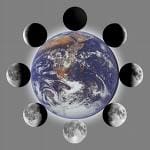Lunation is the mean time for one lunar phase cycle. It is also called as the synodic period . It is on average 29.530589 days, or 29 d 12 h 44 min 3 s. The length of this cycle is linked to many phenomena in nature.In a lunar calendar each month corresponds to a lunation.
Individual lunations vary in length by several hours, because of the eccentricity of the elliptical path described by one celestial body in its orbit of the moon. However, the lunation is never more than 15 hours behind or ahead of a mean lunation.

Falling upon the places of the Benefics, it produces good; upon the Malefics, evil. Aspects to the position of the lunation are interpreted according to the positions of the aspecting planets.
The period of 29d 12h 44m 2.8s between one New Moon and the next - more correctly termed a synodic month.A sidereal lunation, also more correctly termed a sidereal month, is the period of 27d 7h 43m 11.5s intervening between two successive passages of the Moon over the same degree; sometimes termed a Periodical lunation.
An embolismic lunation, correctly termed an embolismic month, is an intercalary month, inserted in some calendars, such as the Jewish, when the 11-days' annual excess over twelve lunar months adds up to 30.
Another Lunation Figure, termed a Synodical Lunation, was cast for the return of the progressed Moon, after birth, to the same distance from the progressed Sun, as that which the radical Moon was from the radical Sun at birth.
Lunation Sensitivity
What is more, a particular lunation occurs at approximately the same degree every nineteen years, so the person's sensitivity to a particular set of sun/moon aspects stays with him all his life.Therefore, someone with any planets or sensitive points at these aspects with 6-8 degree orbs is Lunation Sensitive.
Those who are Lunation Sensitive would always expect another event to happen to them after an even just passed - they would see life as a series of interrelated occurrences. On the other hand, others not Lunation Sensitive would tend to see each event as more isolated, and would be able to see it more thoroughly.
Lunation Cycle
A lunation cycle establishes a period of approximately thirty days during which the relationship between the Sun and the Moon passes through a cycle of aspects, and the Moon undergoes a series of transformations which we witness as the phases of the moon.
When the sun and moon come together for their conjunction (new moon), the moon is in the sky all day with the sun. The sun's brilliance obscures the lesser light of the moon, so it is not seen by day. Neither is it present in the night sky, for at night it is below the plane of the horizon with the sun.
When the moon moves far enough away from the sun to be seen at night, it appears as a thin silver crescent in the western sky after sunset. Each evening the moon appears a little further east of the western horizon toward the middle of the sky, and a little larger. It waxes as it reflects more and more of the Sun's light to earth.
When the moon has moved far enough away from the sun to appear directly overhead at sunset, its shape has become what we call the first quarter moon, indicating that its relationship with the sun spans one quarter of the sky. It appears somewhat like the capital letter D - a semicircle with a straight edge, somewhat like a scythe, cutting across the night sky. After the first quarter, the shape of the moon becomes convex instead of concave.
During the gibbous phase the moon continues to appear a little further toward the eastern horizon each night, until the full face of the moon rises in the east as the Sun sets in the west. The sun and moon are now on opposite sides of the earth. The moon reflects maximum sunlight to earth, and the moon is as far away from the sun as it can get. This phase is appropriately called the full moon.
When the alignment between the sun, moon and earth is exact, a lunar eclipse occurs because the light of the sun casts the shadow of the earth across the face of the moon.
After the full moon, the moon wanes as it passes through its disseminating phase, and reflects less and less of the Sun's light to earth. Each night after sunset it appears at the eastern horizon a little later and a little smaller. When it rises at the eastern horizon at midnight, its shape has again become like a capital D, but the shape of this last quarter moon is oriented in the opposite direction from the first quarter moon. The sun now appears to be chasing the moon, for the moon is above the horizon at dawn, and is banished from view by the Sun's brilliance at sunrise.
Eventually, a thin silver crescent rises just ahead of the Sun. This balsamic phase closes the cycle, for when the small crescent appears at dawn it is almost immediately outshone by the rising sun. Finally the moon no longer appears before the sun and does not appear at night.
Several days later at sunset, the moon appears again as a thin sliver over the western horizon. One cycle has ended and another begun. This new moon, however, does not take place in the same place in the sky or the zodiac as the previous new moon. It occurs about 30' -- one zodiacal sign -- away.